Cavitation Erosion of the Austenitic Manganese Layers Deposited by Pulsed Current Electric Arc Welding on Duplex Stainless Steel Substrates
Abstract
:1. Introduction
2. Materials, Experimental Procedure
- -
- basic-coated electrode: CITOMANGAN;
- -
- electrode diameter: 3.25 mm;
- -
- polarity: cc+;
- -
- pulse current, Ip: 180 A;
- -
- base current, Ib: 90 A (50%Ip);
- -
- mean (average) current, Im: 135 A;
- -
- arc voltage, U: 22 V;
- -
- pulse frequency, f = 1/tc = 5 Hz;
- -
- cycle time, tc = 1/f = 1/5 = 0.2 s;
- -
- pulse time, tp = 0.5 tc = 0.1 s;
- -
- base time, tb = 0.5 tc = 0.1 s (tp = tb);
- -
- arc length, la = 3.0 mm;
- -
- welding speed, v = 27–28 cm/min.
- power of the ultrasonic electronic generator: 500 W
- frequency of vibrations: 20,000 ± 2% Hz
- amplitude of vibrations: 50 μm
- diameter of the sample: 15.8 ± 0.05 mm
- supply voltage: 220 V/50 Hz
- working fluid: tap water, with a temperature of 22 ± 1 °C.
3. Experimental Results
3.1. Hardness Measurements
3.2. Evaluation of Cavitation Tests
- for the experimental value of the cumulative eroded mass:
- for the experimental value of the mean erosion rate, related to the intermediate period:
- for the analytical averaging curve of the experimental values obtained for the mean erosion rates [23,24].where:v(t) = A · (1 − e − B · t) + A · B · t·e − B · tFor i = 1, Δti = 0, Mi = 0, where:
- i represents the number of the intermediate testing period;
- Δmi is the mass of material lost due to erosion in period i, in g;
- Δti is the duration of the intermediate period “i” of cavitation (5, 10, and 15 min);
- A is the scale parameter, statistically established based on experimental values used to draw the approximation/mediation curve, with the condition that their deviations from it are minimal;
- B is the shape parameter of the curve, statistically established based on experimental values. The values of parameters A and B were established in the Mathcad program, version 15.0 based on a model developed in the Cavitation Erosion Research Laboratory in Timișoara [23,24]. Since cavitation is a hydrodynamic phenomenon, whose destructive effect through erosion is strongly dependent on microstructure and cavitation vibratory hydrodynamics, in the diagrams from Figure 5a–c, which express variations in cumulative masses, there is a legend with the values of the standard mean deviation intervening in the relations of the upper (S(t)) and lower (I(t)) boundaries of the dispersion domain of experimental values, known in statistics as the degree of precision or tolerance interval. For a hydrodynamic process, such as cavitation, data from the specialized literature [23,24] show that the tolerance interval values, for a correctly conducted test with rigorously controlled hydrodynamic regime parameters, can have values up to 90% (approximation error of ±10%). The relationships used to determine the standard mean deviation σ and the boundaries S(t) and I(t), according to the literature [23], adapted to the experimental data from the diagrams, have the following forms:
- for the standard mean deviation:
- for the tolerance range 99%:
- for the tolerance range 90%:


- reduced differences between the maximum values of mass losses (maximum 0.13 mg—about 6%), after 165 min. of cavitation erosion;
- regardless of the hardfacing regime, the set of three samples, with one, two, and three deposited layers, exhibit similar behaviors throughout the experiment. At certain durations of cavitation, the mass losses are even identical (1 deposited layer—min. 30, 75, and 105; 2 deposited layers—min. 30, 75, and 105; 3 deposited layers—min. 75 and 135);
- a pronounced/exponential increase during the 0−60 min. of cavitation, followed by a slight decrease, resulting in the linearization of the M() approximation curve. This behavior, according to previous studies [23,24], is dictated by the high values of hardness, homogeneously distributed within the volume of the layer structure attacked by cavitation;
- an identical and high degree of tolerance interval (97%), as well as very small values of the standard mean deviation σ = (0.013−0.02), corresponding to the dispersion range of experimental values, confirming the accuracy of the experimental program and the consistency of the operating parameter values of the vibrating device (amplitude, frequency, water temperature, ultrasonic electronic generator power), as a result of the rigorous control provided by the software implemented in the connected computer.

- insignificant differences (up to a maximum of 0.04 mg/min) between the values of vs, the final erosion rates, towards which the mediation curves asymptotically tend to stabilize;
- high values of erosion rates in the first 5 min, caused by the peaks of surface roughness and the abrasive dust remaining on the cavitated surface after polishing to a roughness of Ra = max 0.2 µm. These values, according to previous experiences and literature data [23,24], do not fully represent the material loss, as cyclic stresses from microjets and cavitation shock waves during this initial period result in elastoplastic deformations and the creation of a crack network;
- the behavior of the three sets of samples, with one, two, and three deposited layers, as indicated by the dispersion of experimental values compared to mediation curves, is within the accepted errors for a dynamic process as complex as erosion generated by vibratory cavitation (see the values of the tolerance field and standard mean deviations in Figure 6);
- the evolution pattern of the mediation curve v(t), reaching a maximum at 75−105 min, with an asymptotic decrease towards the stabilization value vs = 0.014−0.017 mg/min, indicates the significant effect of the coating layer hardness, which continues to harden under cyclic impacts from microjets and shock waves, as well as the attenuation of pressure peaks resulting from these impacts by the air infiltrating into the crack networks and microcavities created;
- for samples with a single deposited layer, the maximum of the v(t) curve (Figure 6a) is reached earlier than for the other two samples (75 min), followed by an asymptotic decrease, indicating slightly lower resistance due to the formation of larger cavities.
- by depositing 2–3 layers of austenitic manganese alloy, the cavitation erosion resistance is significantly higher than that of the Duplex stainless steel structure resulting from the solution heat treatment (reference sample).
- according to the values of the two parameters, the resistance of the deposited layers to cavitation microjet stresses increases compared to that of the solution heat-treated stainless steel by a factor ranging from 8.6 to 11.4, regardless of the parameter considered, MDEmax or Rcav.
- the increase in cavitation resistance achieved by surfaces with two and three deposited layers compared to that of surfaces with a single deposited layer is between 23% and 30%.
3.3. Microstructural Examinations on the Coating-Substrate System
- Ua—electric arc voltage, V;
- Is—welding current, A;
- vs—welding speed, cm/min.
3.4. Surface Topography of the Cavitated Surfaces
4. Conclusions
Author Contributions
Funding
Data Availability Statement
Acknowledgments
Conflicts of Interest
References
- Whitesides, R.W. Interesting Facts (and Myths) about Cavitation; PDHonline: Fairfax, VA, USA, 2012; Volume 225. [Google Scholar]
- Zhao, J.; Ning, L.; Zhu, J.; Li, Y. Investigation on Ultrasonic Cavitation Erosion of Aluminum–Titanium Alloys in Sodium Chloride Solution. Crystals 2021, 11, 1299. [Google Scholar] [CrossRef]
- Carlton, J. Marine Propellers and Propulsion, 2nd ed.; Carlton, J., Ed.; Chapter Cavitation; Butterworth-Heinemann: Oxford, UK, 2012; pp. 209–250. [Google Scholar]
- Ghose, J.P.; Gokarn, R.P. Basic Ship Propulsion; Chapter Propeller Materials; Allied Publishers: Kharagpur, India, 2004; pp. 166–173. [Google Scholar]
- Fitch, E.C. Machinery Lubrication. Chapter Cavitation Wear in Hydraulic Systems. 2011. Available online: http://www.machinerylubrication.com/Articles/Print/380 (accessed on 10 January 2024).
- Escaler, X.; Egusquiza, E.; Farhat, M.; Avellan, F.; Coussirat, M. Detection of cavitation in hydraulic turbines. Mech. Syst. Signal Process. 2006, 20, 983–1007. [Google Scholar] [CrossRef]
- He, Z.; Qin, Z.; Gao, Z.; Wu, Z.; Hu, W. Synergistic effect between cavitation erosion and corrosion of Monel K500 alloy in 3.5 wt% NaCl solution. Mater. Charact. 2023, 205, 113340. [Google Scholar] [CrossRef]
- Zhao, T.; Wang, L.; Zhang, S.; Zhang, C.H.; Sun, X.Y.; Chen, H.T.; Bai, X.L.; Wu, C.L. Effect of synergistic cavitation erosion-corrosion on cavitation damage of CoCrFeNiMn high entropy alloy layer by laser cladding. Surf. Coat. Technol. 2023, 472, 129940. [Google Scholar] [CrossRef]
- Wang, L.; Mao, J.; Xue, C.; Ge, H.; Dong, G.; Zhang, Q.; Yao, J. Cavitation-Erosion behavior of laser cladded Low-Carbon Cobalt-Based alloys on 17-4PH stainless steel. Opt. Laser Technol. 2023, 158, 108761. [Google Scholar] [CrossRef]
- Zhao, T.; Zhang, S.; Wang, Z.Y.; Zhang, C.H.; Zhang, D.X.; Wang, N.W.; Wu, C.L. Cavitation erosion/corrosion synergy and wear behaviors of nickel-based alloy coatings on 304 stainless steel prepared by cold metal transfer. Wear 2022, 510, 204510. [Google Scholar] [CrossRef]
- Wang, Y.; Hao, E.; Zhao, X.; Xue, Y.; An, Y.; Zhou, H. Effect of microstructure evolution of Ti6Al4V alloy on its cavitation erosion and corrosion resistance in artificial seawater. J. Mater. Sci. Technol. 2022, 100, 169–181. [Google Scholar] [CrossRef]
- Chen, F.; Du, J.; Zhou, S. Cavitation erosion behaviour of incoloy alloy 865 in NaCl solution using ultrasonic vibration. J. Alloys Compd. 2022, 831, 154783. [Google Scholar] [CrossRef]
- Karimi, A.; Karimipour, A.; Akbari, M.; Razzaghi, M.M.; Ghahderijani, M.J. Investigating the mechanical properties and fusion zone microstructure of dissimilar laser weld joint of duplex 2205 stainless steel and A516 carbon steel. Opt. Laser Technol. 2023, 158, 108875. [Google Scholar] [CrossRef]
- Kwok, C.T.; Man, H.C.; Cheng, F.T. Cavitation erosion of duplex and super duplex stainless steels. Scr. Mater. 1998, 39, 1229–1236. [Google Scholar] [CrossRef]
- Karimi, A. Cavitation erosion of a duplex stainless steel. Mater. Sci. Eng. 1987, 86, 191–203. [Google Scholar] [CrossRef]
- Al-Hashem, A.; Riad, W. The effect of duplex stainless steel microstructure on its cavitation morphology in seawater. Mater. Charact. 2001, 47, 389–395. [Google Scholar] [CrossRef]
- Wu, Y.; Lian, Y.; Li, Y.; Feng, M. Cavitation Erosion Behavior of 2205 and 2507 Duplex Stainless Steels in Distilled Water and Artificial Seawater. Tribol. Online 2023, 18, 482–493. [Google Scholar] [CrossRef]
- Lakshmi Prasanna, G.; Tanya, B.; Subbiah, R.; Vinod Kumar, V. Effect of nitriding on duplex stainless steel—A review. Mater. Today Proc. 2020, 26, 950–955. [Google Scholar] [CrossRef]
- Garzón, C.M.; Thomas, H.; Francisco dos Santos, J.; Tschiptschin, A.P. Cavitation erosion resistance of a high temperature gas nitrided duplex stainless steel in substitute ocean water. Wear 2005, 259, 145–153. [Google Scholar] [CrossRef]
- Escobar, J.D.; Velásquez, E.; Santos, T.F.A.; Ramirez, A.J.; López, D. Improvement of cavitation erosion resistance of a duplex stainless steel through friction stir processing (FSP). Wear 2013, 297, 998–1005. [Google Scholar] [CrossRef]
- Kwok, C.T.; Lo, K.H.; Chan, W.K.; Cheng, F.T.; Man, H.C. Effect of laser surface melting on intergranular corrosion behaviour of aged austenitic and duplex stainless steels. Corros. Sci. 2011, 53, 1581–1591. [Google Scholar] [CrossRef]
- Standard G32; Standard Method of Vibratory Cavitation Erosion Test. ASTM: West Conshohocken, PA, USA, 2016.
- Bordeasu, I. Monografia Laboratorului de Cercetare a Eroziunii prin Cavitatie al Universitatii Politehnica Timisoara, 1960–2020; Editura Politehnica: Timişoara, Romania, 2020. [Google Scholar]
- Bordeaşu, I.; Patrascoiu, C.; Badarau, R.; Sucitu, L.; Popoviciu, M.; Balasoiu, V. New contributions in cavitation erosion curves modeling. FME Trans. 2006, 34, 39–44. [Google Scholar]
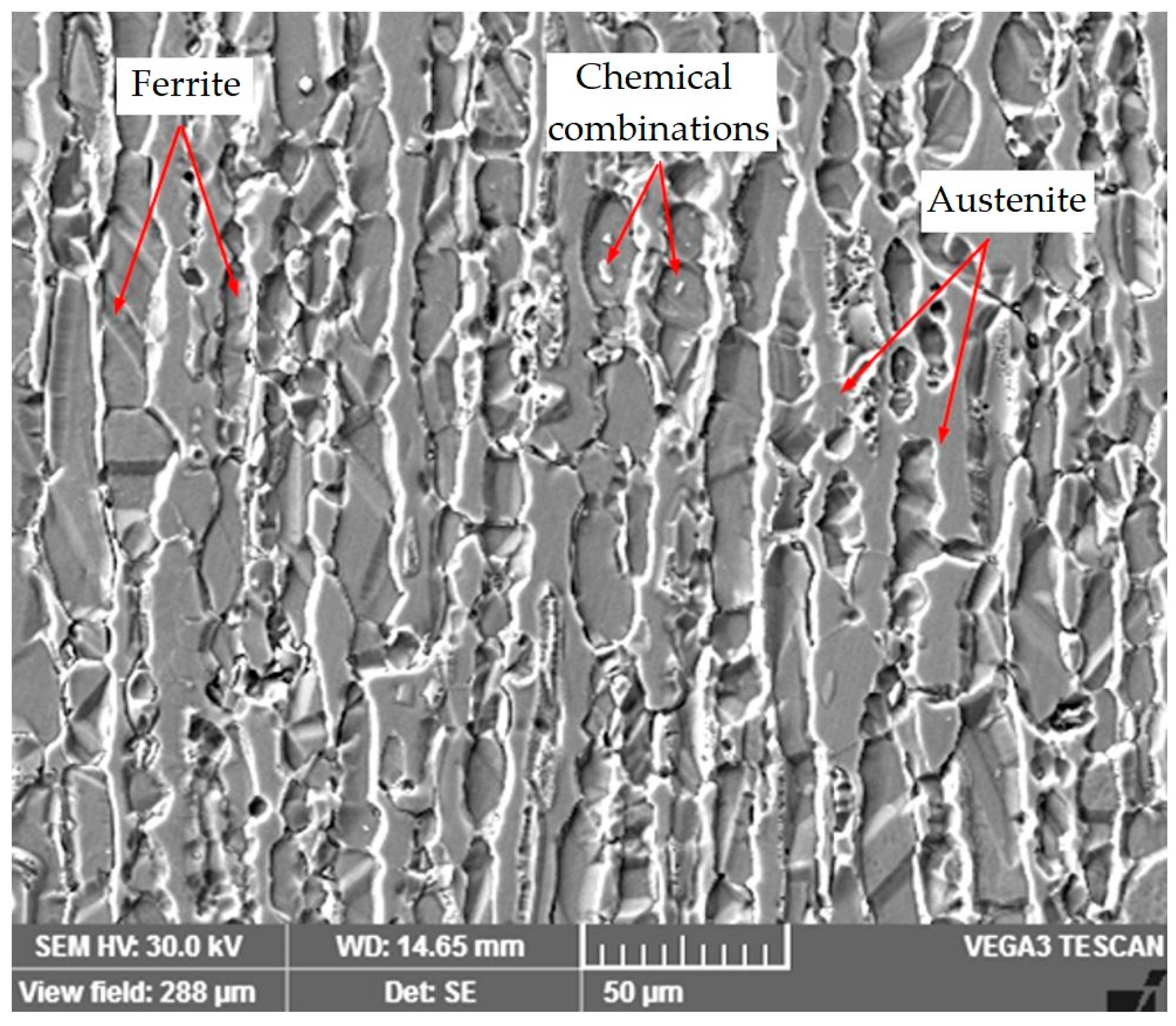

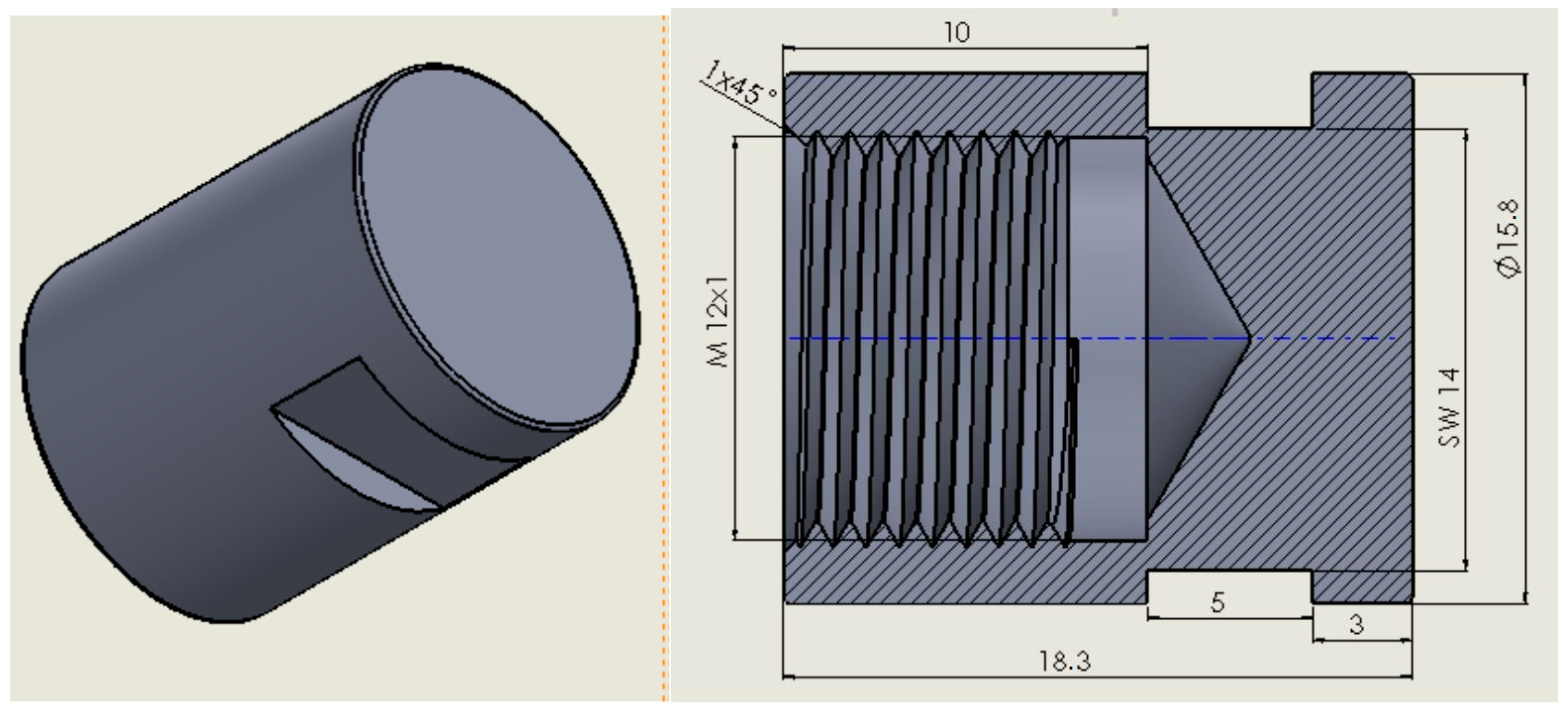
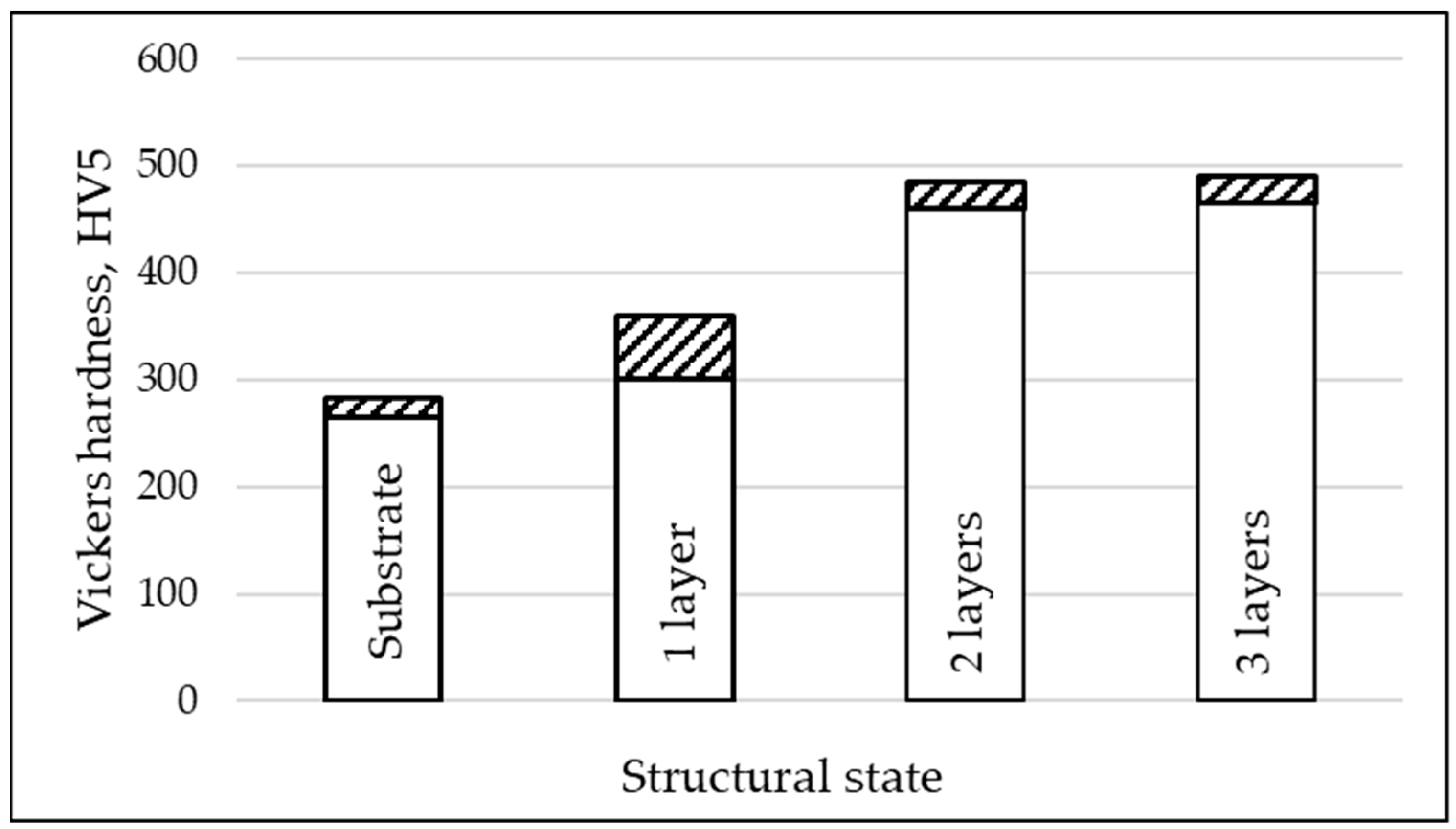
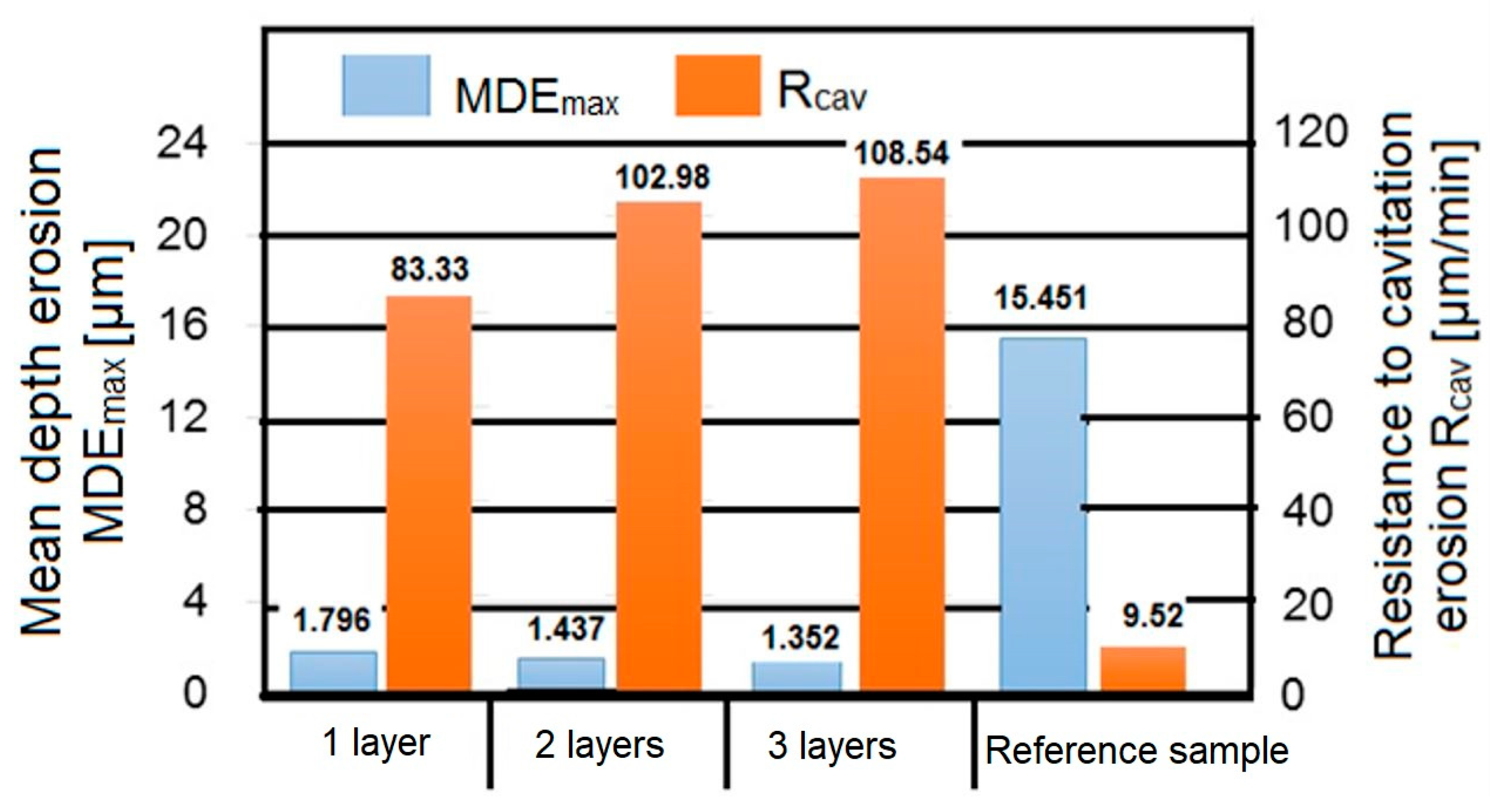

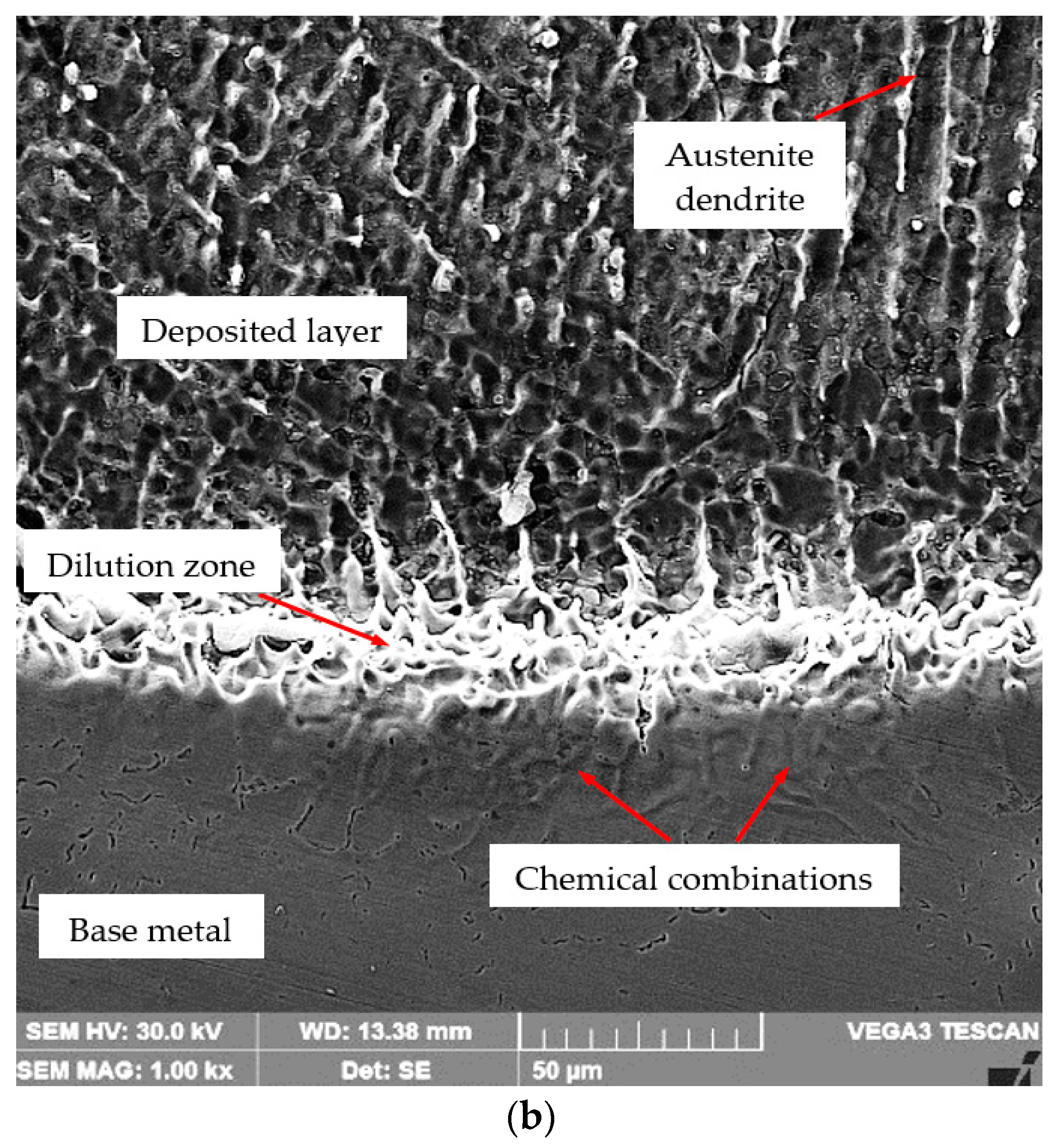



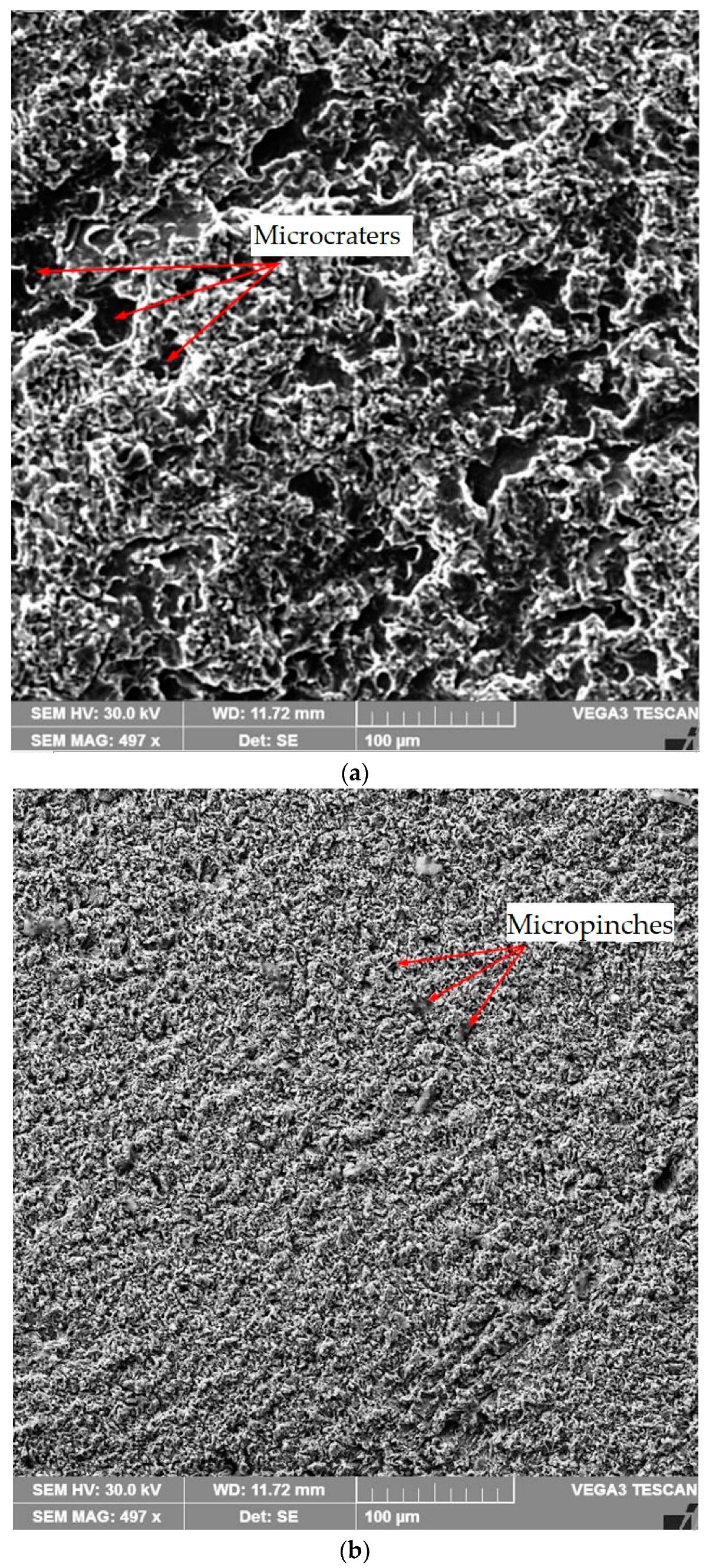
| Carbon (C) | 0.021% |
| Silicon (Si) | 0.79% |
| Manganese (Mn) | 0.82% |
| Phosphorous (P) | 0.019% |
| Sulfur (S) | 0.012% |
| Chromium (Cr) | 22.34% |
| Nickel (Ni) | 5.61% |
| Molybdenum (Mo) | 3.1% |
| Nitrogen (N) | 0.14% |
| Iron (Fe) | Balance |
Disclaimer/Publisher’s Note: The statements, opinions and data contained in all publications are solely those of the individual author(s) and contributor(s) and not of MDPI and/or the editor(s). MDPI and/or the editor(s) disclaim responsibility for any injury to people or property resulting from any ideas, methods, instructions or products referred to in the content. |
© 2024 by the authors. Licensee MDPI, Basel, Switzerland. This article is an open access article distributed under the terms and conditions of the Creative Commons Attribution (CC BY) license (https://creativecommons.org/licenses/by/4.0/).
Share and Cite
Mitelea, I.; Mutașcu, D.; Uțu, I.-D.; Crăciunescu, C.M.; Bordeașu, I. Cavitation Erosion of the Austenitic Manganese Layers Deposited by Pulsed Current Electric Arc Welding on Duplex Stainless Steel Substrates. Crystals 2024, 14, 315. https://doi.org/10.3390/cryst14040315
Mitelea I, Mutașcu D, Uțu I-D, Crăciunescu CM, Bordeașu I. Cavitation Erosion of the Austenitic Manganese Layers Deposited by Pulsed Current Electric Arc Welding on Duplex Stainless Steel Substrates. Crystals. 2024; 14(4):315. https://doi.org/10.3390/cryst14040315
Chicago/Turabian StyleMitelea, Ion, Daniel Mutașcu, Ion-Dragoș Uțu, Corneliu Marius Crăciunescu, and Ilare Bordeașu. 2024. "Cavitation Erosion of the Austenitic Manganese Layers Deposited by Pulsed Current Electric Arc Welding on Duplex Stainless Steel Substrates" Crystals 14, no. 4: 315. https://doi.org/10.3390/cryst14040315
APA StyleMitelea, I., Mutașcu, D., Uțu, I.-D., Crăciunescu, C. M., & Bordeașu, I. (2024). Cavitation Erosion of the Austenitic Manganese Layers Deposited by Pulsed Current Electric Arc Welding on Duplex Stainless Steel Substrates. Crystals, 14(4), 315. https://doi.org/10.3390/cryst14040315








